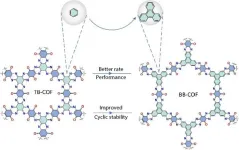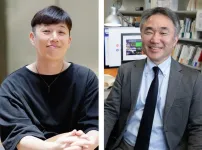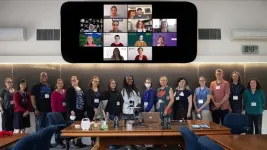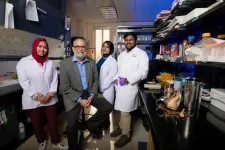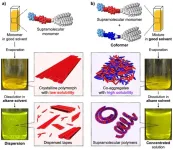(Press-News.org)
What is the mechanism that allows our brains to incorporate new information about the world, and form memories? New work by a team of neuroscientists led by Dr Tomás Ryan from Trinity College Dublin shows that learning occurs through the continuous formation of new connectivity patterns between specific engram cells in different regions of the brain.
Whether on purpose, incidentally, or simply by accident, we are constantly learning and so our brains are constantly changing. When we navigate the world, interact with each other, or consume media content, our brain is grasping information, creating new memories.
The next time we walk down the street, meet our friends, or come across something that reminds us of the last podcast we listened to, we will quickly re-engage that memory information somewhere in our brain. But how do these experiences modify our neurons to allow us to form these new memories?
Our brains are organs composed of dynamic networks of cells, always in a state of flux due to growing up, aging, degeneration, regeneration, everyday noise, and learning. The challenge for scientists is to identify the “difference that makes a difference” for forming a memory – the change in a brain that stores a memory is refereed to as an ‘engram’, which retains information for later use.
This newly published study aimed to understand how information may be stored as engrams in the brain.
Dr Clara Ortega-de San Luis, Postdoctoral Research Fellow in the Ryan Lab and lead author of the article published today in the leading international journal, Current Biology, said:
“Memory engram cells are groups of brain cells that, activated by specific experiences, change themselves to incorporate and thereby hold information in our brain. Reactivation of these ‘building blocks’ of memories triggers the recall of the specific experiences associated to them. The question is, how do engrams store meaningful information about the world?”
To identify and study the changes that engrams undergo that allow us to encode a memory, the team of researchers studied a form of learning in which two experiences that are similar to each other become linked by the nature of their content.
The researchers used a paradigm in which animals learned to identify different contexts and form associations between them. By using genetic techniques the team crucially labelled two different populations of engram cells in the brain for two discrete memories, and then monitored how learning manifested in the formation of new connections between those engram cells.
Then using optogenetics, which allow brain cell activity to be controlled with light, they further demonstrated how these new formed connections were required for the learning to occur. In doing so, they identified a molecular mechanism mediated by a specific protein located in the synapse that is involved in regulating the connectivity between engram cells.
This study provides direct evidence for changes in synaptic wiring connectivity between engram cells to be considered as a likely mechanism for memory storage in the brain.
Commenting on the study, Dr Ryan, Associate Professor in Trinity’s School of Biochemistry and Immunology, Trinity Biomedical Sciences Institute, and the Trinity College Institute of Neuroscience,said:
“Understanding the cellular mechanisms that allow learning to occur helps us to comprehend not only how we form new memories or modify those pre-existent ones, but also advance our knowledge towards disentangling how the brain works and the mechanisms needed for it to process thoughts and information.
“In 21st century neuroscience, many of us like to think memories are being stored in engram cells, or their sub-components. This study argues that rather than looking for information within or at cells, we should search for information between cells, and that learning may work by altering the wiring diagram of the brain – less like a computer and more like a developing sculpture.
“In other words, the engram is not in the cell; the cell is in the engram.”
END
A drug that boosts bone growth in children with the most common form of dwarfism, may also reduce their chances of sudden infant death syndrome, sleep apnoea and needing surgery, according to a new study.
The international research trial, led by Murdoch Children’s Research Institute (MCRI) and published in The Lancet Child & Adolescent Health, has showed for the first time that vosoritide treatment increases height, facial volume and the size of the foramen magnum, the hole at the base of the skull that connects the brain with the spinal cord, in children under five with achondroplasia.
MCRI is the largest vosoritide ...
Zinc — cheap, abundant, environmentally friendly — may be the answer to better batteries, but there’s a major problem: Aqueous zinc ion batteries (AZIBs) cannot match lithium-ion batteries in terms of power output. To test what electrode material composition might be able to bring AZIBs up to par, a research team based in China developed two organic frameworks with the same constituents but arranged in different ways.
When put to the test, the framework with appropriate density of active sites — where the zinc ions gain electrons to recharge the ...
On October 13, 2023, in Addis Ababa, Armauer Hansen Research Institute (AHRI) and BGI Genomics signed a Memorandum of Understanding to enhance the Institute's genomics and precision medicine capabilities.
The Institute got its name from the Norwegian physician, Gerhard Henrik Armauer Hansen, who first described the leprosy bacillus (Mycobacterium leprae) and joined the Ethiopian Ministry of Health in 2004. Located in Addis Ababa, it serves as a biomedical hub for the region.
BGI Genomics provides ...
This study delves into the behavioral complexities of autism spectrum disorder (ASD) by introducing the rigid-autonomous phase sequence (RAPS) formation concept. RAPS are may be responsible for the cognitive, sensory-motor, and memory-related challenges faced by individuals with ASD. By uniting these insights under a single theoretical framework, this research paves the way for innovative treatments, promising a brighter future for those with ASD.
Autism spectrum disorder (ASD) is a complex neuropsychiatric condition, marked ...
Success in science, technology, engineering, and mathematics (STEM) demands keeping up with the latest tools and techniques. The AI boom, for example, has made coding and data management skills integral. But going back to school isn’t an option for most scientists. Short training programs like webinars and boot camps have become a popular alternative among busy STEM professionals. However, these formats can have significant shortcomings. There’s often no guarantee attendees will leave with the skills needed to advance their careers. And they can be exclusionary, preventing learners of all abilities and circumstances from benefiting equally.
“We’ve ...
EL PASO, Texas (Nov. 21, 2023) – Neurodegenerative disorders, including Alzheimer’s, Parkinson’s and Huntington’s, affect millions of people in the United States, and the cost of caring for people who live with these conditions adds up to hundreds of billions of dollars each year.
Now, researchers from The University of Texas at El Paso may potentially have found a solution in used coffee grounds — a material that is discarded from homes and businesses around the world every day.
A team led by Jyotish Kumar, a doctoral student in the Department of Chemistry and Biochemistry, and overseen by Mahesh ...
Gender stereotypes harm people of both genders—and society more broadly—by steering and sometimes limiting people to behaviors, roles, and activities linked with their gender. Widely shared stereotypes include the assumption that men are more central to professional life while women are more central to domestic life. Other stereotypes link men with math and science and women with arts and liberal arts. Perhaps surprisingly, research has shown that countries with higher economic development, individualism, and gender-equality tend to also have more pronounced gender differences in several domains, ...
Supramolecular polymers (SPs) are molecular assemblies composed of non-covalently bonded small molecules. They show high recyclability originating from their dynamic nature of monomer binding, which is different from covalent polymers with non-biodegradable nature. The small repeating units that form SPs, called monomers, are specifically designed to construct multiple non-covalent bonds to enhance the stability of the resulting SPs. Such monomers can be organized into structurally distinct assemblies by forming various ...
Osaka, Japan – To age or not to age! How does aging affect organisms on a cellular level? What mechanisms help cells survive self-inflicted or external harm? It is known that lysosomes—critically important cellular structures—are crucial for digesting damaged cellular components and pathogens, and maintain stability within cells and tissues. But can they also be repaired, and if so, how?
In a study published this month in EMBO Reports, researchers from Osaka University and Nara Medical University have shown that damaged lysosomes are repaired by a mechanism called “microautophagy” and have identified two key regulators of this ...
Mount Sinai Health System announced that Brendan Carr, MD, MA, MS, a nationally recognized leader in academic medicine and health policy, will be its next Chief Executive Officer.
Dr. Carr joined Mount Sinai as its head of emergency medicine in February 2020, just before New York City became the initial epicenter of the COVID-19 pandemic in the United States. He played a critical role during the pandemic and led local, regional, and national initiatives focused on improving the Health System’s emergency and critical care capacity. He was ...
